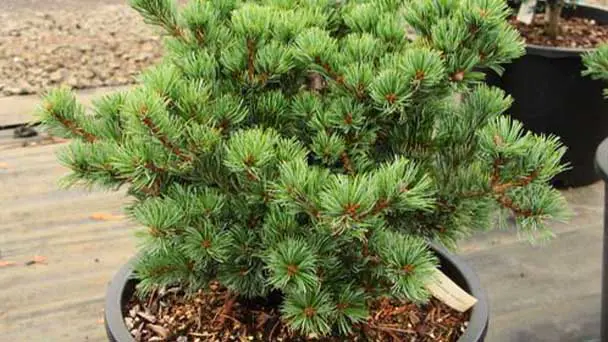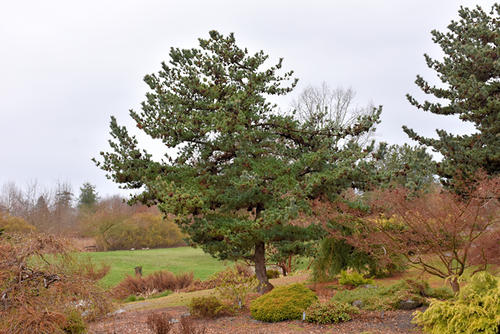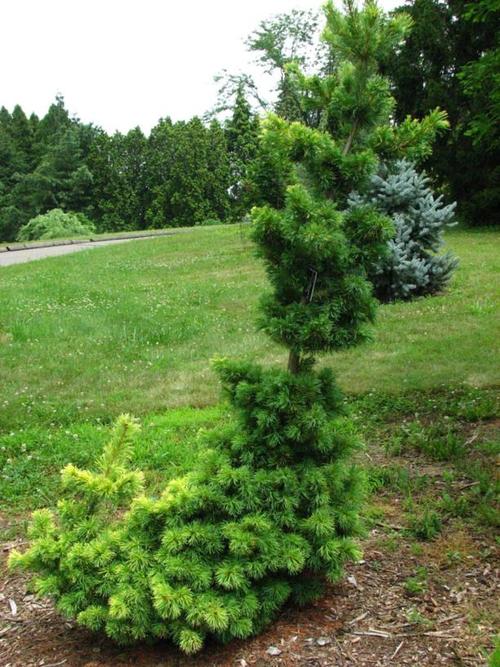How to Grow & Care for Pinus Parviflora (Japanese White Pine )
Written by Maggie
Nov 11 2021

Pinus Parviflora (Japanese White Pine ), a four seasons evergreen foliage plant, it leaves short branches dense, elegant posture, is the production of bonsai superior tree species. In life, there are many people who want to grow Pinus Parviflora. Now, let's look at how to grow and care for Pinus Parviflora.
Pinus Parviflora Quick Info
| Botanical/Scientific Name | Pinus Parviflora |
| Common Name | Five-needle pine |
| Uses | Antiseptic, diuretic, rubefacient and vermifuge |
| Origin | Japan |
| Light Care | Supplemental lighting |
| Soil Care | Tolerate most soil types |
| Temperature Care | Withstands temperatures of -10°C in winter. |
| Humidity Care | Moisture |
| Watering | Sufficient watering during the growing season |
| Pruning Care | Be pruned gradually in the course of repotting |
| Fertilizer Care | A slow release (pellet based) fertilizer |
| Propagation | Take cuttings from white pines in fal |
| Toxic | Non-toxic |
Pinus Parviflora Care in Detail
Pinus Parviflora Watering
Pinus Parviflora likes a humid environment. The temperature rises in summer. It can be watered once a day to ensure that the soil is wet. In spring and autumn, pinus parviflora can be watered once every 2 or 3 days to make sufficient water supplement. When the temperature drops in winter, the five needle pine enters the dormancy period, and the roots cannot be absorbed, so watering needs to be reduced.During the growth period of Pinus parviflora, more watering is needed to effectively promote the growth of branches and leaves. In summer, the temperature rises and the environment is dry. It is necessary to spray water in the air and on the leaf surface to cool and moisturize. The temperature drops in winter to ensure that the soil is slightly dry. Ponding will cause frostbite at the root of Pinus parviflora.
When watering Pinus parviflora, we should water along the edge of the flowerpot instead of flooding, which will lead to the loss of nutrients in the soil. In summer, the temperature rises and the water evaporation rate is fast. We need to water Pinus parviflora in the morning and evening. The temperature is appropriate, which is conducive to the absorption of roots. After watering, it needs to be turned over.
Pinus Parviflora Temperature
Pinus parviflora is a relatively cold resistant plant, so it can endure a low temperature environment of about 6 degrees. Therefore, when we maintain Pinus parviflora, we cannot lower its minimum temperature below 10 degrees, so that it can grow well. Moreover, when maintaining five needle pine in winter, it needs to be moved back indoors, and Pinus parviflora needs to be grown in a sunny place. At the same time, it also needs to increase ventilation and reduce watering.Pinus Parviflora Humidity
The softwood cutting of Pinus parviflora requires air relative humidity between 80% and 95%. When the temperature is low in winter, Pinus parviflora will go through the dormancy period. At this time, planting does not need too much watering. Generally, it is OK to keep the soil wet and dry. When planting Pinus parviflora in winter, we should keep warm. Pinus parviflora likes to grow in a warm and ventilated environment. During planting, ensure good ventilation and air humidity up to standard.Pinus Parviflora Repotting
Pinus parviflora has a beautiful tree posture and is often planted as an ornamental bonsai. The five needle pine grows very fast. When planting, the pot soil should be changed for the plant every two years. How can the five needle pine change the pot. We can usually carry out Pinus parviflora repotting in spring and autumn. When changing pots, it is best to replace ceramic flowerpots or tile pots, and try not to replace plastic pots.The plastic pot has poor air permeability and drainage. Planting five needle pine in this pot is not conducive to plant growth. It is easy to suffer from waterlogging in the planting process. When we carry out Pinus parviflora repotting, we can properly trim the plant roots. When pruning, it is mainly to cut off the rotten position of the plant root. After pruning, it can be properly applied with liquid medicine for disinfection.
Pinus parviflora likes to grow in loose, fertile and well drained acidic soil. The replaced soil can be mixed with rotten leaf soil, coal ash and vermiculite. When changing soil, keep the original soil at the root and half of the old soil, which can make the plant adapt to the new soil faster and is conducive to the later growth of the plant.
Pinus Parviflora Soil Care
Japanese white pine prefers soft, fertile soil that drains well, and soil that is acidic. Alkaline soil can affect its growth. The flowers provide a recipe for soil that works for most plants, and Japanese white pine is no exception. This is a mixture of leaf rot, garden soil, compost, and sand in a 3:5:1:1 ratio, and then it is used for planting. When we grow and care for Japanese white pine, it does not need to be replanted every year, but only once every three years, in the spring or autumn when it is not too hot or too cold.
Pinus Parviflora Light Care
Pinus parviflora like plenty of sunlight, so they can bask in the sun in spring, fall, and winter so that their leaves grow stronger and more green. Without sunlight, they will become thin and dry. But in summer, you can't be exposed to the sun. After all, the sun is too strong, and the plants can easily stand the high temperature and get hurt. When we grow and care for Japanese white pine, be selective in the sun, the noon sun must be avoided, you can pull a sunshade net, can also spray cooling, it will save the move to move.
Japanese white pine grows most quickly in the spring and autumn, so be sure to get enough water to grow at this time, perhaps once a day. Be sure to water the plants regularly to make them grow quickly. When we grow and care for Japanese white pine in summer, its growth will decline sharply, the plant needs less water at this time, but the evaporative force of the environment is larger, so we must water reasonably. Generally every morning need to be watered once, and then in the evening to spray some water mist moisturizing on the line.
Japanese white pine does not grow at all in winter, so water it only once every three to five days to maintain basic survival needs. Japanese white pines do not like too much moisture, so they should be kept dry and well ventilated so that their plants can grow healthily.

Pinus Parviflora Fertilizer Care
Pinus parviflora does not need too much fertilizer because too much and too much fertilizer can cause the plants to grow too fast and spoil their shape. When we grow and care for Japanese white pine, the best time to fertilize in the spring and autumn when the growth is vigorous, summer and winter is not needed. Appropriate application of some cake fertilizer is enough, the plant after absorption can grow more robust, but should pay attention to a small amount of multiple fertilization, must not be greedy or more greedy.
Pinus parviflora Pruning
When we grow and care for Japanese white pine in the spring growth period of the new shoot, in order to make the pine needle short and compact, should be the new shoot by hand to pick 1/3-1/2, pay attention to not use scissors to cut, pick after not spraying water, to make the wound dry to spray, for too dense branches, diseases and insects withered branches should be timely pruning; When the base leaves of Japanese white pine turn yellow naturally, the leaves should be removed gently in time. This kind of yellow leaves will not only affect the appearance, but also create conditions for the overwintering of diseases and insects.
Read more:
Japanese White Pine: Grow & Care for
Pinus Parviflora Disease & Pest Control
Pinus parviflora diseases include leaf wilt and pine deciduous disease. In addition to the removal of disinfected leaves, the initial onset of the disease can be sprayed with 50% carbendazim or 70% methyltozine solution of 600 -- 800 times; It was found that the Pine Shoot Borer could be sprayed with 1200 times 40 diethoate or 500 times Bt emulsion. The diseases of japanese white pine include rust, root rot and coal stain. The main pests are scale insects, aphids, red spiders and demoiselle moths. Spray Bordeaux once or twice in winter to prevent disease.

Pinus Parviflora Propagation
Pinus Parviflora Cutting Propagation
During Pinnus parviflora cutting propagation, we'd better intercept branches on robust plants, and the intercepted branches should be disease-free. After interception, it is best to put the branches in carbendazim for disinfection, and then put the branches in a cool place to dry.
Pinus parviflora likes to grow in loose, fertile, breathable and well drained acidic soil. The cutting soil can be mixed with rotten leaf soil, coarse sand, vermiculite and coal ash in proportion. After preparation, it is best to place the soil in the sun for disinfection, and then water the soil once in order to supplement water.
This watering should be thorough, but try not to leave ponding to prevent affecting the later growth of the plant. If you want the branches to take root early, you can wipe some rooting powder at the bottom of the branches during cutting. Finally, insert the treated branches into one third of the soil. After the completion of Pinus parviflora cutting propagation, we'd better place the plants in a semi shade and ventilated place for maintenance.
Pinus Parviflora Sowing Propagation
We should treat the seeds of Pinus parviflora before sowing, such as sand accumulation. Seeds can also be soaked in warm water at 50 to 60 degrees. Generally, treated seeds can be sown and drill sown.
When it grows into seedlings, build a shading shed to keep the soil moist to avoid sudden collapse. If the seedlings are raised in containers, they should also be transplanted once, so as to ensure the survival rate of Pinus parviflora breeding propagation, which is suitable for its growth characteristics. Therefore, if you want large-scale planting, you can choose a place with good drainage and irrigation conditions, flat terrain and convenient transportation, which can effectively reduce the cost.
Pinus Parviflora Grafting Propagation
The selection of rootstock for Pinus parviflora grading propagation selects the old pile of potted black pine that has begun to take the shape of bonsai. The grafted branches of Pinus parviflora are generally the best without scales less than six or seven years old. Pinus parviflora grading propagation time is generally the best period from mid February to early March when buds will germinate but not before germination.
The best bud is the main bud, and the best branch is three branches. The determination of the number of scions generally depends on the size of the tree crown and the length of the rootstock branches. Generally, the long rootstock branches can receive 3 to 5 scions, and the short one is enough.
The management after budding is simple, that is, it is placed in the open air without shading. In case of spring drought, spray water on the tree crown appropriately. After grafting, the pots are moved into the greenhouse or plastic shed, and spray regularly to keep the humidity at about 80%. After grafting survival, the growth of rootstock branches shall be controlled. When the branches of five needle pine are about to grow to match the size of rootstock trunk, all rootstock branches shall be cut off.
When to Plant Pinus Parviflora
Pinus parviflora can be planted at any time, but it is more suitable to plant Pinus parviflora from March to April every year, because if five needle pine is planted at this stage, the germination rate of Pinus parviflora is relatively higher.
When does Pinus Parviflora Bloom&Harvest
In indoor breeding, if the cultivation method of Pinus parviflora is strictly followed, the most suitable growth environment is provided, and more attention is paid to water, fertilizer and light. After three years or more, Pinus parviflora will bloom in May. However, the specific flowering time is also different due to regional differences. Pinus Parviflora flowers are not very good-looking, but they are better than rare, and they look very chic against the backdrop of needle-like leaves.
Pinus Parviflora Benefits
Pinus parviflora is not only a commonly used bonsai tree species but also five needle pine can be used as a kind of tea. Regular drinking can strengthen the five internal organs. Pinus parviflora five needle pine has excellent medicinal ingredients, and the taste of five needle pine tea is not astringent.
Latest Updated
- Benefits of Bugleweed - 7 Science-backed Health Benefits
- Bugleweed Dangers & Side Effects - Is It Poisonous?
- How to Plant Evergreen Trees - What You Should Know
- When to Plant Evergreens - Grow Guide for Evergreen Trees
- 12 Wonderful Evergreen Shrubs for Your Garden
- 12 Popular Evergreen Plants with Pictures for Beginners
- When And How To Prune A Lilac Bush Like a Pro
- How to Grow & Care for Lilac Vine (Hardenbergia Violacea)
- Japanese Lilac Tree (Syringa Reticulata) Care & Propagation Guide
- Shumard Oak Pros and Cons - What to Know
Popular Articles
- Winter maintenance of Antirrhinum Majus
- How to Grow Terminalia Mantaly Tree
- How to Grow and Care for Crossostephium Chinense
- How to grow Antirrhinum Majus in spring
- Peristeria Elata (Dove Orchid) Profile: Info & Care Guide
- Underwatered Snake Plant (Sansevieria Trifasciata) - Signs And How To Fix
- How to Care for Brazilian Jasmine Plant (Mandevilla Sanderi)
- How to Grow & Care for Graptopetalum Purple Delight in Summer
- Rosa Chinensis (China Rose): Plant Growing & Care Tips
- How to Care for Baby Sun Rose (Aptenia Cordifolia)